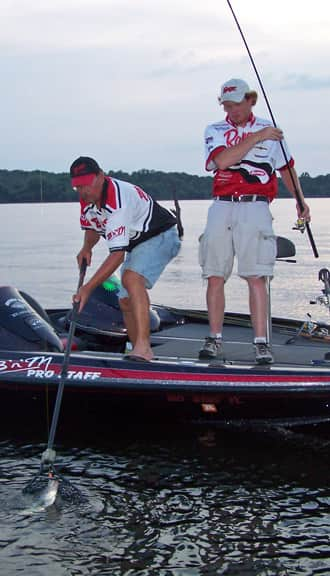Bunting Team Takes “World Series” of Crappie Angling
OutdoorHub 10.30.12

Missouri-Based Duo Relies on Electronics to Dial In Cold Front Crappies
Father and son crappie pros Charles and Travis Bunting recently took home top honors in the crappie equivalent of the Bassmaster Classic—the 2012 Crappie Masters National Championship—held on Tennessee-Tombigbee Waterway in Mississippi.
But it wasn’t a walk through the park. Not even for two seasoned slab slayers.
“The first day of the tournament wasn’t bad—we brought in our seven fish for 9.10 pounds and fifth place—but we moved between 28 and 32 times for those fish. Then it rained 6 ½ inches on Sunday, greatly reducing water clarity and creating 5 to 6 mph river current,” says the younger Bunting, Travis.
Not easily discouraged, the two anglers knew what they had to do—adapt and find fish—their mantra for the entire 2012 All American Tournament Trail. So rather than following fellow competing anglers up the creek arms and oxbows, the two took a big gamble and stayed in the main river, current and all.
“I knew we stood a really good chance of catching bigger fish in the less-pressured main river,” says Travis. “Plus, I have a lot of confidence in my Humminbird Side Imaging. First, it allows us to locate potentially fish-holding structure, then we can examine that structure for fish, and lastly, we can pinpoint exactly where in the structure we need to fish by zooming in closer.”
Working this three-prong approach, the Bunting team stayed in the top 10 all season, typically scanning for crappie-rich structure 60 feet off each side of the boat, or a lengthy 150 feet when fishing large flats.
Repeating these surgical tactics paid off as they worked the lower lock of Mississippi’s Tennessee-Tombigee, waters the Missouri-based anglers hadn’t fished prior to pre-fishing for the 2012 National Championship earlier in the week … under much better weather conditions.
“Electronics have really changed the name of the game,” says Travis. “In the case of this tournament, we looked for structure close to back eddies and current breaks, knowing that these fish wanted out of the fast stuff. And we could literally see the bigger fish in that lower lock buried on the bottom in the deepest, gnarliest wood. Then it was as easy as moving the cursor on the 1198 over the wood and zooming in for a better look.”
Running a Humminbird 1198c SI in the back and an 1158c in the bow, the Buntings also make the most of networking capabilities for strategic, tactical and practical purposes.
“On river systems, which can have a lot of structure that’s here one day and not the next, we don’t have to mark every spot. During pre-fishing we’ll find spots with Side Imaging, slow down, swing back around and fish, and if we pull a fish, we’ll mark the spot on the front 1158. The cool thing about the simple Ethernet connection is then the spot shows up in green on the back 1198. That means our back unit is clean of blue markers and we can easily distinguish our pre-fishing spots from new spots.”
Once fish-holding structure is located with Side Imaging, the team quickly positions into place with their Minn Kota Fortrex 101, which the Buntings praise for its real-world reliability and flexible, indestructible composite shaft. “We move from spot to spot at over 3 mph with the Fortrex and when we do hit wood it doesn’t usually sound pretty. But there’s never been any damage … and we bust a lot of wood.”
And that’s the reality of the hardcore crappie game. Often times, to catch fish you’ve got to position the boat directly over the top of wood, brush and other nasty structure—like the situation Travis and Charles found themselves in on Day Two of the National Championship.
Once on top of structure, though, it’s all good. That’s when Travis switches his bow-mounted Humminbird 1158 view to traditional sonar. This allows him the ability to further identify where in the structure the crappies are located from the vertical perspective.
In the case of the tournament—considering cold front conditions—it was then a matter of placing their six rod splay of double-minnow rigs tipped with 2 ½-inch shiners straight down into tiny strike zone windows.
“Sure, we broke off a lot, like 40 rigs the first day,” says Travis. “But you’ve got to lose fish to catch fish, especially in conditions like we had when the water is high and fast. Those fish bury in deep and you have to put the bait right in front of their noses, literally. That’s why we shortened the hook spacing to a foot and sized up in weights to 3/8 ounce. There were no fish on the edges, everything was right in the lumber, so you had to keep your baits right there to get bit.”
“But location was the key to the Championship, and we owe 80% of our success to our Humminbird units,” says Travis. “We found fish-holding wood fast and eliminated a ton of dead water. Not only that, we could identify with a high degree of certainty money fish right on the screen.”
While it certainly seems the father and son had ability and technology on their side, what’s a tournament without a cameo from Lady Luck?
By noon of Day Two the duo had their seven fish but one had been deeply hooked and they feared it might not hold up for weigh-in. So, rather than fish to the very bitter end and gamble for an even bigger fish, they hung it up a full hour and half early.
The result? A second day weight of 9.90 pounds and a two-day total of 19 pounds even, nearly a pound and a half over the second place team of Paul Eldridge and TJ Harper. Congratulations on the prestigious honor of being crowned 2012 Crappie Masters National Champs!

